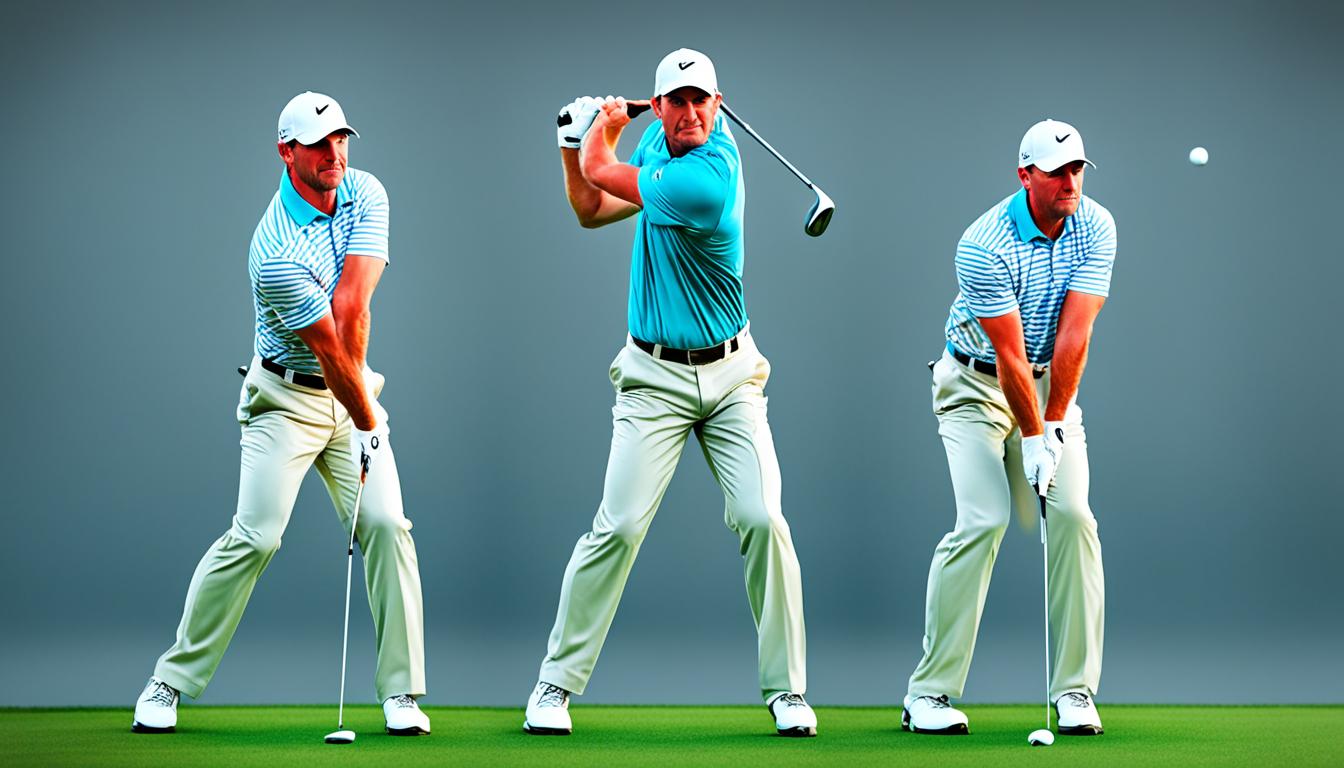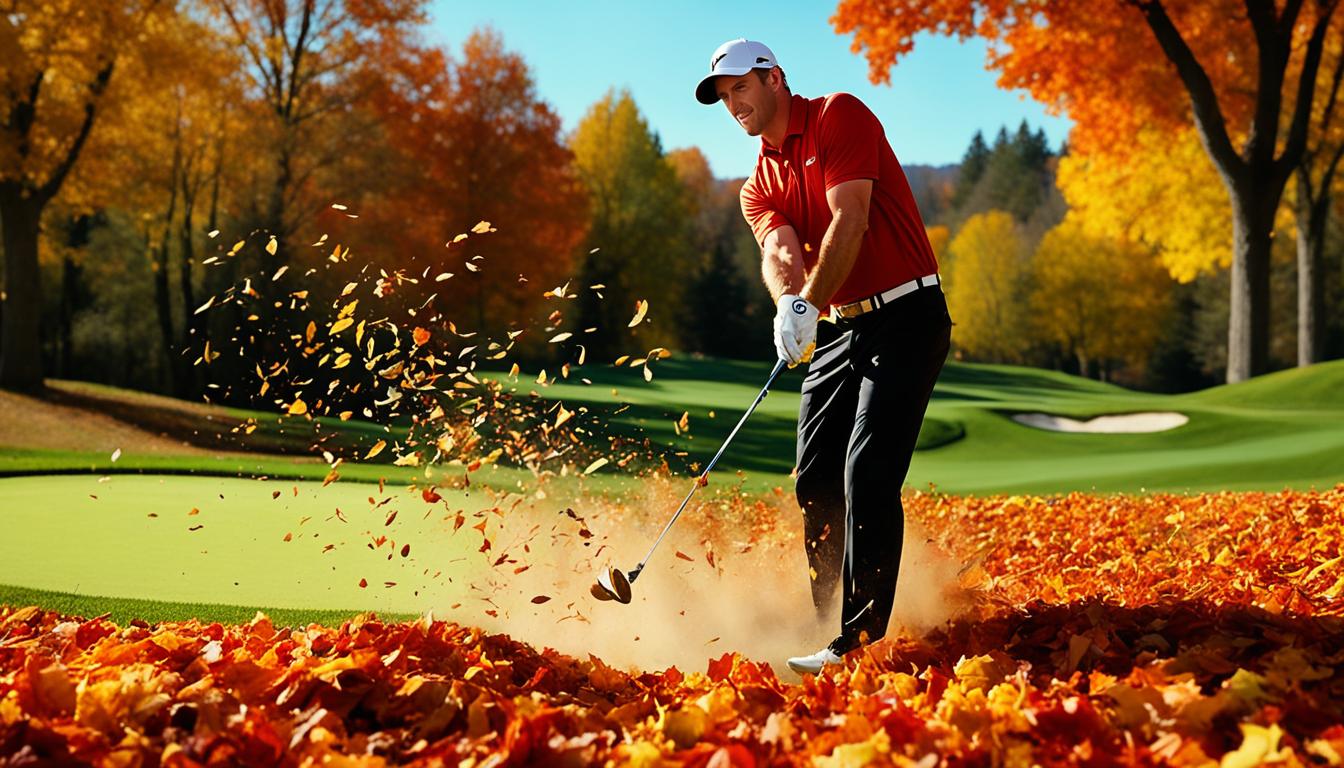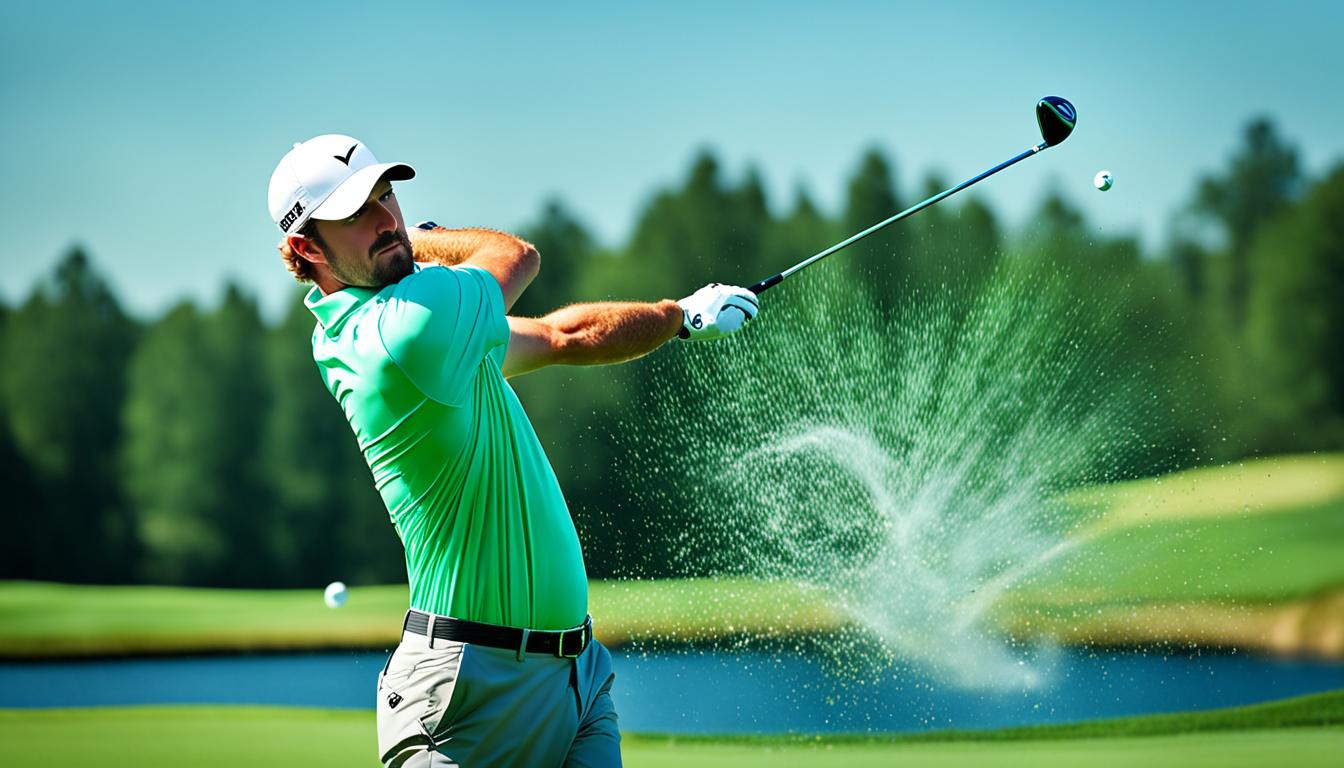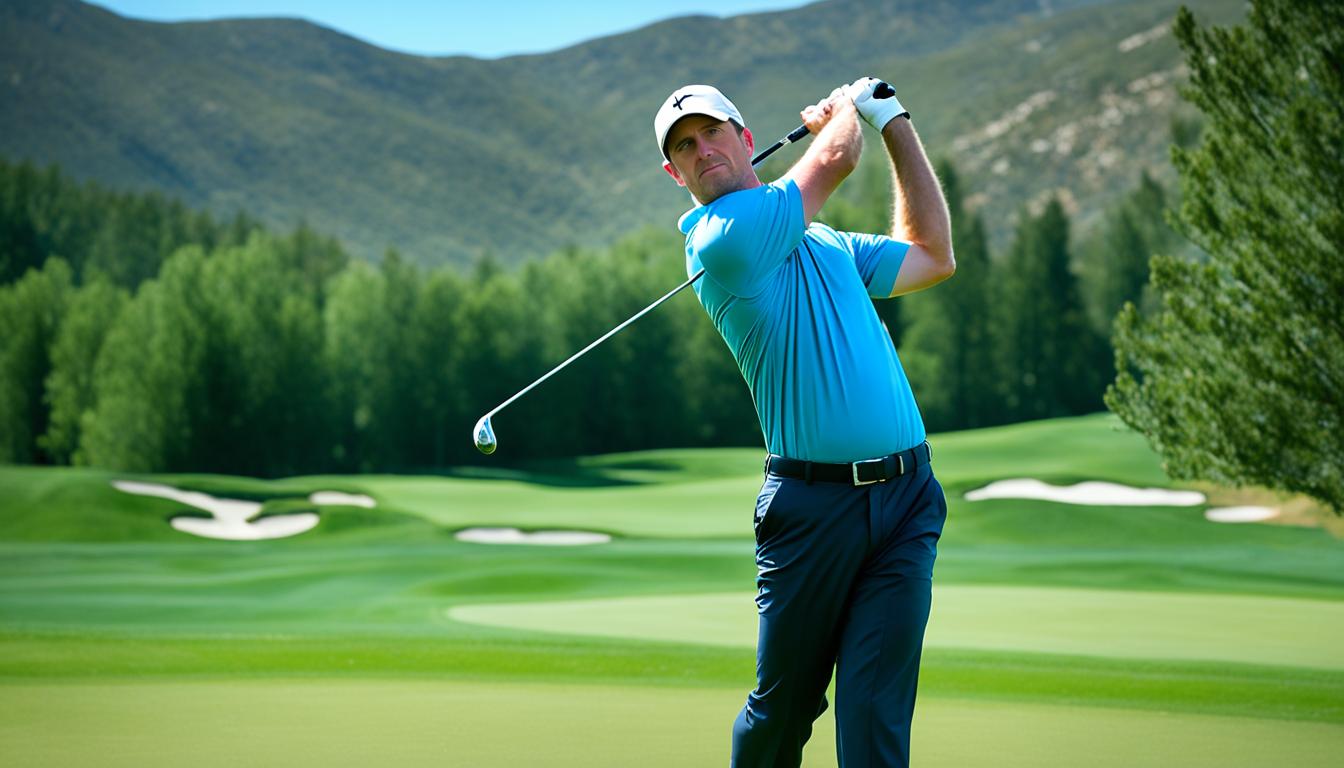Mastering the art of the golf swing involves understanding and utilizing the role of footwork. The legs serve as the foundation of stability, the engine of power generation, and the initiators of a seamless kinetic chain in the golf swing. Proper leg usage can enhance distance, accuracy, and consistency in the swing. In this guide, we will explore the importance of using the legs in a golf swing, techniques for maximizing leg involvement, and common footwork mistakes to avoid.
Key Takeaways:
- The legs are essential for stability, power generation, and coordination in the golf swing.
- Proper leg usage can improve distance, accuracy, and consistency in shots.
- Avoid common footwork mistakes to maintain proper leg mechanics and sequencing.
- Incorporate leg-focused drills to strengthen key muscles and improve coordination.
- Professional instruction and video analysis can help refine leg mechanics and footwork.
The Importance of Legs during a Golf Swing
When it comes to developing a powerful and efficient golf swing, the importance of legs cannot be overstated. Your legs serve as the foundation for stability, power generation, and the initiation of a kinetic chain that allows for a seamless and fluid swing. By understanding the role of your legs and maximizing their usage, you can achieve greater distance, accuracy, and consistency in your shots.
One of the primary functions of the legs in a golf swing is to provide stability and balance. By maintaining a solid base and proper leg positioning throughout your swing, you can establish a strong platform for generating power and maintaining control over the clubhead. This stability allows you to stay balanced throughout the swing, preventing swaying or loss of control that can lead to inconsistent contact with the ball.
Furthermore, the legs play a vital role in generating power and distance in your shots. As you transfer your weight from your back leg to your front leg during the downswing, the legs act as a catalyst for generating clubhead speed. This transfer of energy through the legs and into the club creates a powerful whip-like action, resulting in explosive ball speed and increased distance.
Additionally, the legs initiate the kinetic chain in the golf swing—a series of sequential movements that allow for a smooth and efficient transfer of energy from the ground up. The proper sequencing of the legs, hips, torso, and arms ensures that power is generated and transferred efficiently throughout the swing. This coordinated movement pattern maximizes clubhead speed and control, leading to consistent and accurate ball-striking.
PGA Tour players exemplify the significance of leg power in the golf swing. They rely on their legs to achieve impressive three-hundred-yard drives, showcasing the potential for increased distance and power when your legs are utilized effectively. By prioritizing leg engagement and mastering the proper leg mechanics, you can unlock your full swing potential and elevate your performance on the golf course.
Next, we’ll delve into specific techniques and drills for using your legs in the golf swing, allowing you to develop a solid foundation, maximize power generation, and optimize your performance on the course.
Using Your Legs in the Golf Swing
Effectively utilizing the legs in the golf swing requires proper setup, timing, and coordination. It all starts with the proper setup in golf. Address the ball with a shoulder-width stance, distributing the weight evenly between both feet. Flex the knees slightly to establish a stable posture, allowing for a dynamic and controlled motion.
During the leg usage in backswing, the weight shifts to the rear foot, acting as a pivot point for the upper body and hips to rotate around. This transfer of weight helps create tension and potential energy, setting the stage for a powerful downswing.
In the downswing, it’s crucial to initiate the movement with a powerful leg drive toward the target. This forceful leg action generates speed and propels the entire body forward, preparing for impact. The legs function as the engine of power generation, contributing significantly to the overall clubhead speed and distance achieved.
As we transition to impact and follow-through, the legs continue to play a crucial role. They provide support and leverage for clean ball contact and a smooth finish. The lower body’s stability ensures that the upper body can rotate freely, allowing for a complete and balanced swing.
Remember, the proper utilization of your legs throughout the golf swing is essential for optimal performance. Keep in mind the setup, weight shift, leg drive, and support during the impact and follow-through. By effectively engaging your legs, you’ll experience improved power, consistency, and control in your shots.
| Leg Usage in Golf Swing | Benefits |
|---|---|
| Proper Setup in Golf | Establishes stability and balance |
| Leg Usage in Backswing | Creates tension and potential energy |
| Leg Usage in Downswing | Generates power and clubhead speed |
| Impact and Follow-through | Provides support and leverage for clean ball contact |
By mastering the proper leg usage in the golf swing, you’ll unlock the potential for greater distance, improved accuracy, and a more consistent swing pattern. Now that you understand how to utilize your legs effectively, let’s explore some common footwork mistakes to avoid in the next section.
Common Footwork Mistakes in Golf
When it comes to mastering the golf swing, proper footwork is essential. Unfortunately, there are several common footwork mistakes that golfers often make. These mistakes can negatively impact stability, balance, and power generation, leading to inconsistent ball contact and compromised performance on the course. In this section, we will discuss three common footwork mistakes to avoid in your golf swing: sway, hip over-rotation, and a loss of balance.
Sway in Golf Swing
Swaying during the swing refers to lateral movement of the lower body, where the hips and legs shift sideways instead of rotating properly. This mistake can disrupt stability and balance, making it difficult to achieve consistent contact with the ball. Swaying can also cause a loss of power generation, as the energy is misdirected due to improper weight transfer. It’s important to maintain stability and avoid excessive lateral movement to ensure a solid foundation for your swing.
Hip Over-rotation in Golf Swing
Hip over-rotation occurs when the hips rotate too much during the backswing, leading to an overextended turn. While some rotation is necessary for power generation and creating torque, excessive hip rotation can result in a loss of control and coordination. Over-rotation can also cause the upper body to become out of sync with the lower body, affecting the timing and sequencing of the swing. It’s crucial to maintain a balanced and controlled rotation to optimize your golf swing.
Loss of Balance in Golf Swing
Another common footwork mistake is a loss of balance during the swing. This can occur due to improper weight distribution or a lack of stability in the lower body. When balance is compromised, it becomes challenging to maintain consistent contact with the ball and execute a fluid swing motion. It’s essential to establish a solid foundation by evenly distributing your weight between both feet and maintaining a stable posture throughout the swing.
By avoiding these common footwork mistakes, you can ensure proper leg usage and sequencing in your golf swing. Let’s take a closer look at each mistake and explore strategies to address them.
| Footwork Mistake | Impact on Swing | Correction Technique |
|---|---|---|
| Sway in Golf Swing | Disrupts stability, balance, and power generation | Focus on maintaining stability and avoiding excessive lateral movement |
| Hip Over-rotation in Golf Swing | Loss of control, coordination, and synchronization | Work on maintaining a balanced and controlled rotation |
| Loss of Balance in Golf Swing | Difficulty in maintaining consistent contact and fluid motion | Establish a solid foundation with proper weight distribution and stability |
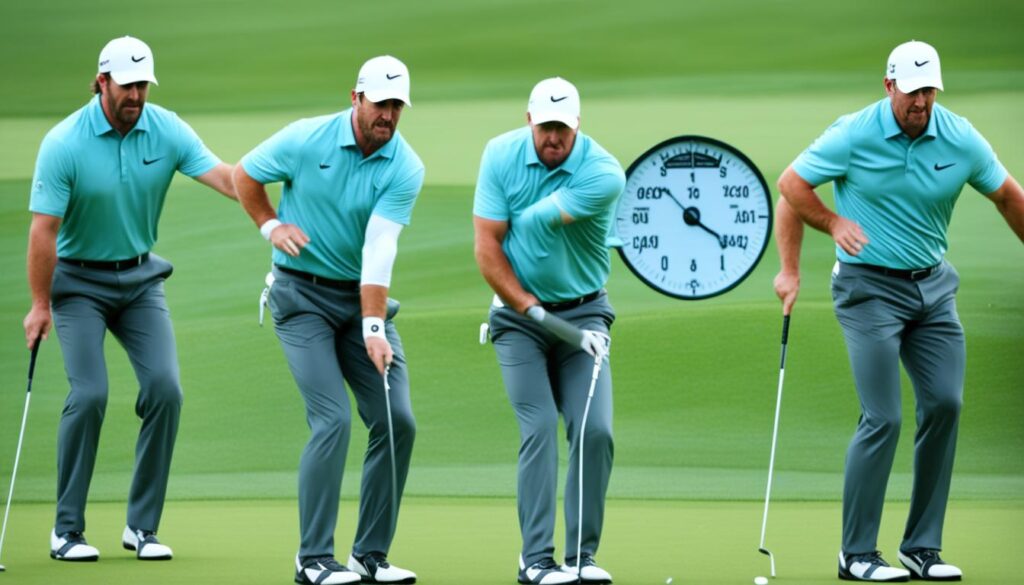
Now that we’ve identified these common footwork mistakes and discussed their impact on the golf swing, let’s explore effective techniques and drills to correct and improve your footwork in Section 5.
Tips for Improving Leg Usage in the Golf Swing
Improving leg usage in the golf swing is crucial for achieving a powerful and consistent swing. By incorporating leg-focused drills and techniques, you can strengthen key muscles, enhance coordination, and improve overall performance on the course. Here are some valuable tips to help you optimize your leg usage:
- Leg-focused drills for golf: Integrate exercises like lateral lunges, squats, and single-leg balance exercises into your training routine. These drills target the muscles involved in leg movement and stability, promoting better control and efficiency in your swing.
- Tempo and rhythm drills for golf: Practice drills that emphasize the synchronization between your lower body and upper body. These drills enhance fluidity in your swing and help you maintain proper tempo, resulting in improved distance and accuracy.
- Seek professional golf instruction: Working with a qualified golf instructor can provide personalized guidance and feedback on your leg mechanics and footwork. They can analyze your swing, identify areas for improvement, and provide specific drills and exercises tailored to your needs.
- Utilize video analysis: Take advantage of video analysis tools to assess your leg usage and overall technique. By reviewing your swing in slow motion or from various angles, you can identify any inconsistencies or flaws in your leg movement and make the necessary adjustments.
By incorporating these tips into your training regimen, you can enhance your leg usage in the golf swing and elevate your overall performance on the course. Remember, practice and consistency are key to mastering any skill, and improving your leg mechanics is no exception. So, put in the effort, stay committed, and enjoy the rewards of a powerful and efficient golf swing.
The Power of Proper Leg Usage
Proper leg usage in the golf swing is key to unlocking greater distance, accuracy, and consistency in your shots. The legs act as the engine of the swing, providing stability, power, and coordination throughout the entire motion. By coordinating the upper and lower body, you can generate effortless speed and unwavering consistency, just like the PGA Tour players.
When you utilize your legs correctly, you harness the body’s kinetic energy, resulting in more power generation in your golf swing. This power translates into longer drives and better control over the ball. By leveraging the strength and stability of your legs, you establish a solid foundation for your swing, enabling you to generate maximum force and execute a smooth, controlled motion.
Proper footwork and leg mechanics allow you to transfer energy efficiently from your lower body to your upper body. This transfer of energy produces leverage in your golf swing, amplifying the force applied to the clubhead and increasing your clubhead speed. The result is more powerful and accurate shots.
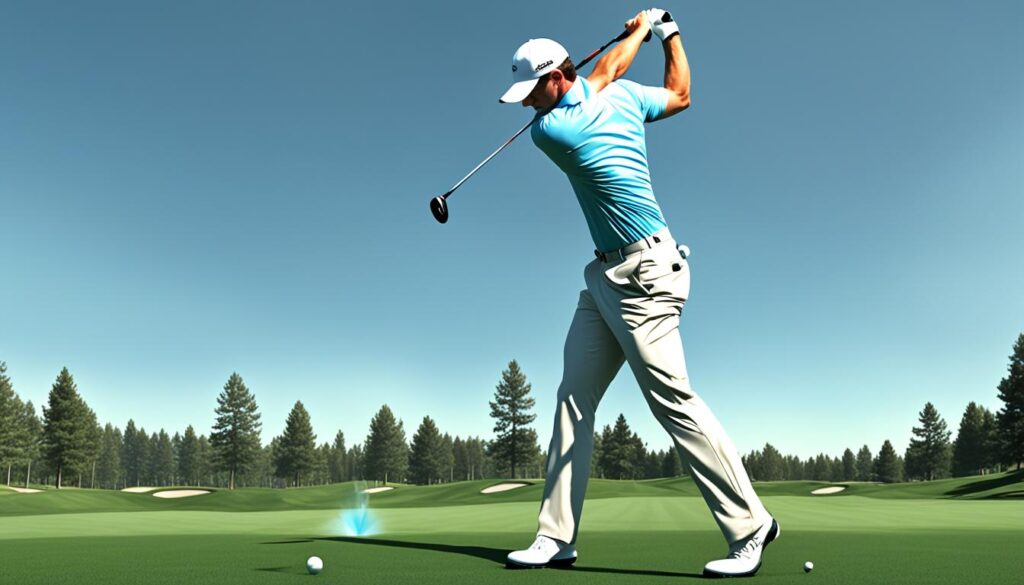
To optimize your leg usage in the golf swing, focus on footwork and positioning throughout your swing. Start by ensuring a balanced setup, evenly distributing your weight between both feet. As you initiate the backswing, shift your weight to your rear foot, creating a coiled position and setting the stage for a powerful downswing. During the downswing, drive off your front foot, transferring your weight from back to front, and generating maximum power as you strike the ball.
Remember, proper leg usage not only enhances power generation but also improves the overall coordination of your swing. It allows the different parts of your body to work together in harmony, resulting in a fluid and seamless motion. By emphasizing the importance of leg mechanics and footwork, you can unlock the full potential of your golf swing and elevate your performance on the course.
The Role of Footwork in Longevity
As golfers age, maintaining proper footwork and leg usage becomes increasingly important for longevity in the game.
Improving leg mechanics and sequencing can help mitigate the effects of age-related changes in coordination and balance. Consistent practice and technique refinement can ensure that golfers maintain power generation and stability in their swings as they continue to play the game.
By prioritizing leg engagement, golfers can continue to enjoy a powerful and efficient golf swing throughout their golfing years.
| Importance of Leg Usage | Tips for Maintaining Coordination |
|---|---|
|
|
| “Proper leg usage results in consistent contact with the ball, enhanced control over the clubhead, and increased clubhead speed.” | “Improving leg mechanics can unlock the full potential of the swing and improve overall performance on the course.” |
Conclusion
In conclusion, proper footwork and leg usage are essential components of a powerful and effective golf swing. By understanding the role of the legs in providing stability, power generation, and coordination, golfers can enhance their distance, accuracy, and consistency on the course. Refining leg mechanics and avoiding common footwork mistakes are key steps in maximizing leg involvement in the swing.
Incorporating leg-focused drills, such as lateral lunges and squats, can strengthen the leg muscles and improve coordination. Additionally, emphasizing tempo and rhythm in the swing can promote synchronization between the lower and upper body. Seeking professional instruction and utilizing video analysis tools can further enhance leg mechanics and overall technique.
By prioritizing the proper engagement of the legs, golfers can unlock the full potential of their swings. The legs serve as the engine that drives power and leverage in the swing, resulting in increased clubhead speed and consistent ball striking. Therefore, golfers should continue to prioritize the importance of footwork and leg usage, as they play a significant role in achieving longevity and success in the game.
FAQ
What role does footwork play in a powerful golf swing?
Footwork plays a crucial role in providing stability, power generation, and coordination throughout the golf swing. By utilizing the legs properly, golfers can achieve greater distance, accuracy, and consistency in their shots.
How important are the legs during a golf swing?
The legs are vital in providing stability, power generation, and initiating the kinetic chain in a golf swing. Proper leg usage can result in consistent ball contact, control over the clubhead, and increased clubhead speed.
How should I use my legs in the golf swing?
Proper leg usage involves maintaining a stable setup, shifting weight during the backswing, initiating a powerful leg drive in the downswing, and offering support and leverage at impact and follow-through.
What are some common footwork mistakes in golf?
Common footwork mistakes include swaying or sliding during the swing, over-rotation of the hips, and improper weight distribution. These mistakes can disrupt balance, coordination, and power generation in the swing.
What are some tips for improving leg usage in the golf swing?
To improve leg usage, golfers can incorporate leg-focused drills such as lateral lunges, squats, and single-leg balance exercises. Tempo and rhythm drills can also promote fluidity and synchronization between the lower and upper body. Working with a qualified golf instructor and utilizing video analysis tools can provide personalized guidance for improving leg mechanics.
How does proper leg usage contribute to power generation in the golf swing?
Proper leg usage harnesses the body’s kinetic energy to generate power and achieve greater distance in the golf swing. The legs act as the engine of the swing, providing stability, coordination, and leverage for an efficient and powerful motion.
How does footwork contribute to longevity in the game of golf?
Maintaining proper footwork and leg usage becomes increasingly important as golfers age. By improving leg mechanics and sequencing, golfers can mitigate age-related changes in coordination and balance, allowing them to continue to enjoy a powerful and efficient golf swing over the years.
In summary, what is the role of footwork in a powerful golf swing?
Footwork in a golf swing is essential for stability, power generation, and coordination. By prioritizing proper leg mechanics and footwork, golfers can unlock the full potential of their swing, resulting in greater distance, accuracy, and consistency in their shots.
